The Leading Edge: June 2022 Wind Energy Newsletter
In this edition, we celebrate women in engineering and share advances in standards, tech, and potential at conferences, via webinars, and in the news.
News Stories
Premier Wind Energy Technical Conference Highlights NREL Research
"Giving the lead-off plenary talk to the entire conference was an amazing opportunity to bring the issues in the grand challenges to the wind energy science community," Veers said. "At the end of the conference, parts of the presentation were being used by Delft University of Technology Professor Dominic von Terzi to explain the issues of wind integration with hydrogen production."
With the support of the European Academy of Wind Energy and the International Energy Agency Wind Technology Collaboration Programme, a series of 10 papers about the grand challenges is being published in Wind Energy Science. Written by more than 100 wind energy researchers worldwide, the series reviews the breadth of wind energy research needs and proposes actions to help reach global decarbonization goals.
In addition to the keynote, NREL presenters included:
- Emmanuel Branlard and Jason Jonkman (Dynamic Inflow and Unsteady Aerodynamics Models for Modal and Stability Analyses in OpenFAST)
- Matt Hall (An Open-Source Frequency-Domain Model for Floating Wind Turbine Design Optimization)
- Patrick Moriarty (Design of American WAke ExperimeNt Field Campaign)
- Kelsey Shaler (Efficient Loads Surrogates for Waked Turbines in an Array)
- Eric Simley (Investigating the Impact of Atmospheric Conditions on Wake Steering Performance at a Commercial Wind Plant)
- PJ Stanley (Multi-Timescale Wind-Based Hybrid Energy Systems).
NREL staff also serve on the organizing committee of this biennial conference, which attracts academics and industry research and development engineers. This was the largest TORQUE conference ever, with more than 500 in-person attendees and about 60 registered online.
"TORQUE is a great forum to demonstrate NREL’s leadership at the cutting edge of wind energy," said Garrett Barter, NREL’s group manager for wind energy science. "Through presentations, organizing committee membership, and several side meetings that develop as a result of our TORQUE participation, NREL receives a broad audience for our research and the opportunity to develop future partnerships with industry and other researchers."
Veers added that giving a presentation at TORQUE is a great opportunity, as the selection process is quite competitive. In addition, in-person attendance allowed NREL researchers to talk to new industry people and rekindle old acquaintances with the goal of working together on critical issues.
"The hallway discussion and conversations over posters (there were over 200 poster exhibits) are priceless," he said.
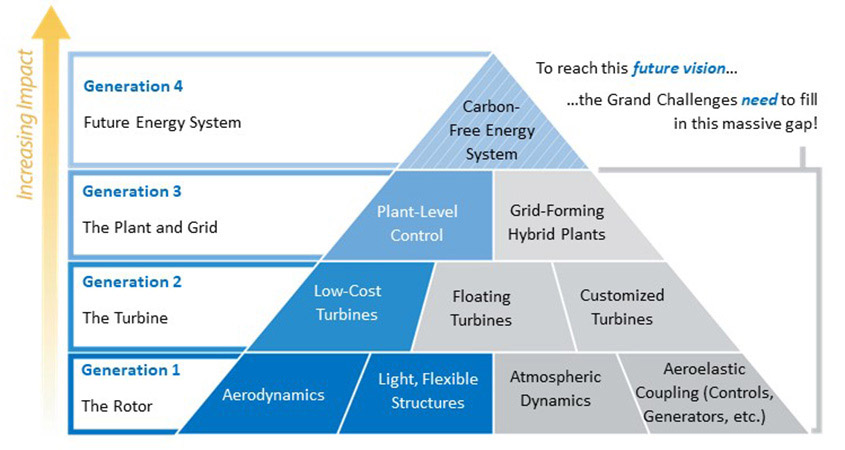
NREL Senior Research Fellow Paul Veers gave the keynote address at The Science of Making Torque from Wind conference. He discussed the international effort underway to define the grand challenges of wind energy science—and used this pyramid to explain how the efforts in each generation of wind energy success have left gaps that need to be filled to meet the expectation of a carbon-free energy system. Image by Paul Veers, NREL
How Not To Short-Circuit the Grid When Adding Wind Energy
Researchers at NREL have learned a lot about how to reliably integrate large amounts of wind and solar power onto the grid—including making sure the grid is protected if there is a fault, such as a short circuit.
In today's power system, fault current (an electrical surge caused when, for example, a short circuit occurs due to wires touching or a tree falling on a power line) is mostly produced by synchronous generators in fossil, nuclear, and hydroelectric plants. However, the inverter technology used by wind and solar power instead of synchronous generators is not typically designed to produce large amounts of fault current—so in a future grid with high levels of solar power and wind energy, the power system may need to find new ways to provide fault protection.
In a new guidebook and video, NREL explains how to solve this challenge and maintain power systems protection with higher levels of renewables in the future grid. To educate policymakers and other interested stakeholders, NREL researchers have released Understanding Power Systems Protection in the Clean Energy Future, which provides a brief overview of system protection and fault current in maintaining a safe power system. This work was funded by the U.S. Department of Energy’s (DOE) Wind Energy Technologies Office.
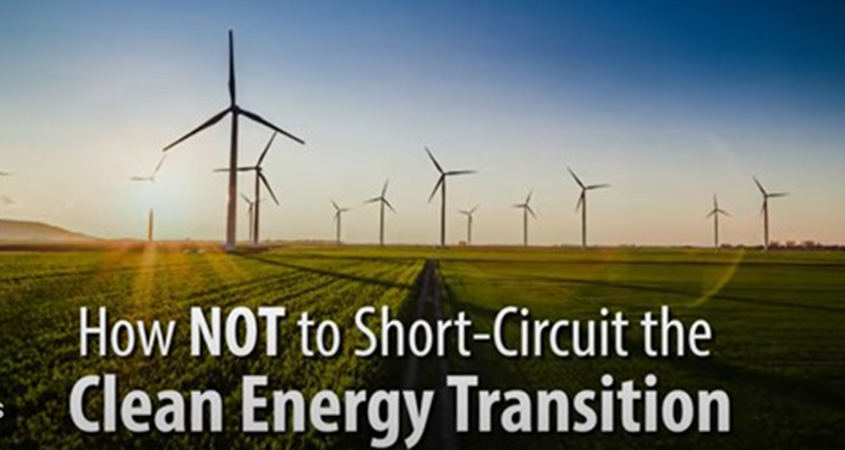
A new NREL video describes how to avoid faults in the power grid with increased renewable energy contribution. Screenshot by NREL
Behind the Blades
Motivated Management for Offshore Wind Energy Projects
June 23 was International Women in Engineering Day, so this month we are highlighting an engineer who keeps NREL’s offshore wind energy research growing.
Ten years ago, Setareh Saadat learned about NREL while earning her bachelor’s degree in mechanical engineering at the University of Colorado Boulder. Working with NREL’s solar power team to complete her year-long capstone project, she fell in love with the experience. Now, she’s back at the lab, this time as a project manager and coordinator for NREL’s booming offshore wind energy research program.

Setareh Saadat’s program management supports NREL’s offshore wind energy research and helps to combat the energy crisis while improving sustainability and environmental protection and safety. Photo courtesy of Setareh Saadat, NREL
Offshore wind energy is a growing industry with promise. With the help of NREL experts and resources, research projects document offshore resources, evaluate potential wind farm sites, and help design, improve, and validate technology for harsh marine environments. Saadat keeps track of all those projects, maintaining or adjusting course as needed, checking schedules and deadlines, and coordinating with her NREL colleagues, including Walt Musial, Rebecca Green, Amy Robertson, and Garrett Barter as well as partners and collaborators.
"I believe that effective project management through efficient resource management, in concert with the technical and scientific research effort, can contribute to the overall efficiency and successful outcome of projects," she says. With the Biden administration’s goal of substantially increasing the country’s offshore wind energy capacity by 2030, there’s a lot of hope in the successful outcome of projects such as the Atlantic Offshore Wind Transition Study and the Supply Chain Road Map for Offshore Wind Energy.
"I hope to be able to impact the field through enhanced project management as well as continuous process improvement," says Saadat, who holds a master’s degree in engineering and technology management from Colorado School of Mines and received certification in project management (PMP).
Her motivation lies not just in solutions for the global energy crisis. She’s also a proponent of the environmental protection and safety benefits of promoting and proposing renewable energy solutions, such as protecting marine life and wildlife. "The idea of renewable energy, the thought of being able to discover alternative fuel options, the ability to create sustainability—this is why I chose NREL," she says. Saadat joined NREL's team in December 2021.
Saadat enjoys hearing about and learning from the research she supports and is continuously fascinated with novel discoveries and products. Supporting them enables her to contribute to important progress. "I believe," Saadat says, "that through renewable energy research initiatives and sustainable energy sources we can achieve something good."
What gets Saadat out of bed every morning and at her desk to handle the next item on her to-do list and keep NREL’s offshore wind energy efforts advancing? "Knowing that I am involved in an effort that works toward saving the planet and providing a more green and bright future for the next generation and on."
On the Radar
Introducing the 2022 Electricity Annual Technology Baseline
The 2022 Electricity Annual Technology Baseline is now available. For the first time, the baseline includes distributed wind and pumped storage hydropower supply curve data, along with the annual cost and performance updates to all technologies.
This collaborative project is led by NREL and supported by DOE. The report integrates current and projected cost and performance data for electricity-generation and storage technologies into one user-friendly format. Distributed wind data is from NREL’s recent Distributed Wind Energy Futures Study—a highly detailed, comprehensive analysis of opportunities for widespread U.S. deployment of distributed wind in 2035. The study found distributed wind has economic potential of nearly 1,400 gigawatts, today—or more than half of the current U.S. annual electricity consumption.
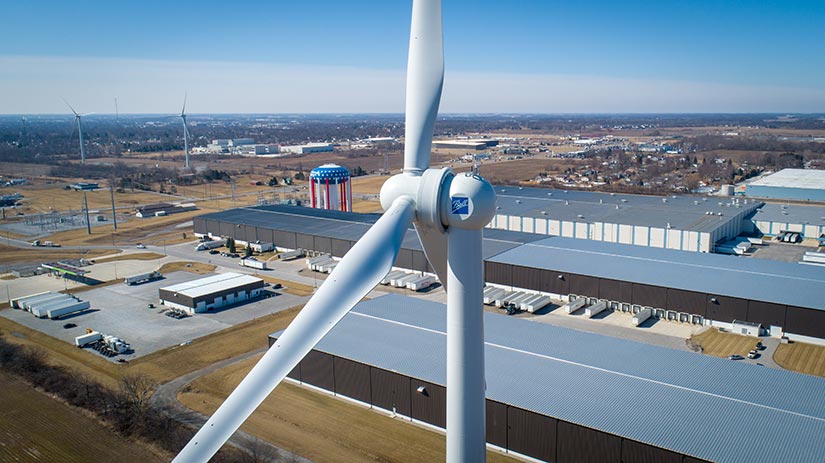
A Decade of Transformation: What We Have Learned Since Renewable Energy Futures Study
A lot has happened since the Renewable Electricity Futures Study was released in 2012. The study featured research by more than 110 experts from 35 organizations, including NREL, into whether a future U.S. power system with very high levels of renewable electricity generation was possible. And the short story is that renewable energy, such as wind, is integrating faster and cheaper than expected.
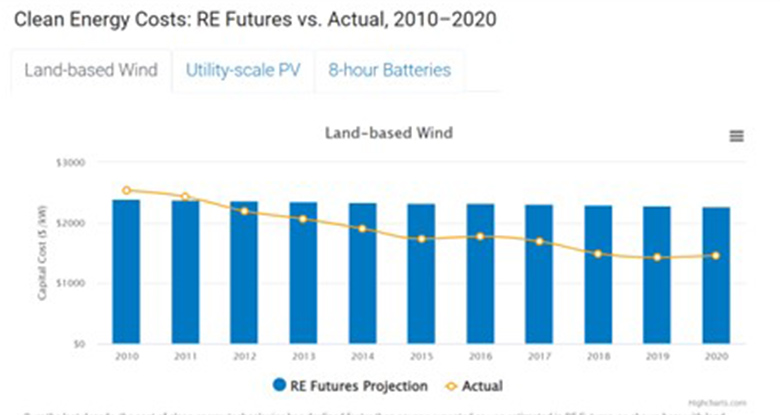
Over the last decade, the cost of clean energy technologies has declined faster than anyone expected or was estimated in RE Futures, as shown here with land-based wind, utility-scale solar, and 8-hour batteries. Note: the capital costs are in real 2020 dollars per kilowatt and the RE Futures estimates did not account for construction interest and interconnection costs. Graph and screenshot by NREL
In 2021, wind energy produced 12% of U.S. electricity, or enough to power more than 31 million homes—tripling since the DOE-funded study was released. Between 2012 and 2020, U.S. wind, solar, and geothermal generation increased at an annual compound growth rate of 15%. If this rate continues, these sources of energy could produce enough electricity to meet all current U.S. demand by 2035.
Over the past decade, the cost of clean energy, such as land-based wind (by about 40% since the study) and related technologies have declined faster than anyone expected or was estimated in the Renewable Energy Futures Study.
Upcoming Events
Aug. 30–Sept. 1, 2022, Boulder, Colorado: Sixth Wind Energy Systems Engineering Workshop
Join NREL, the Technical University of Denmark, and the University of Colorado Boulder at the Sixth Wind Energy Systems Engineering Workshop. Hear from speakers in academia, industry, and international research laboratories and discuss topics relevant to systems engineering and the wind industry. Learn more and register.
July 13, 2022, 1–2 p.m. Virtual: WINDExchange Offshore Wind Webinar: Technology Below the Water
The final webinar in NREL’s Offshore Wind Technology Basics series—hosted by the DOE’s WINDExchange initiative, NREL, and the University of Massachusetts Amherst offshore wind energy experts—focuses on offshore wind technology below the water, including foundations and cables. Register to attend or to get the recording if you can't make it.
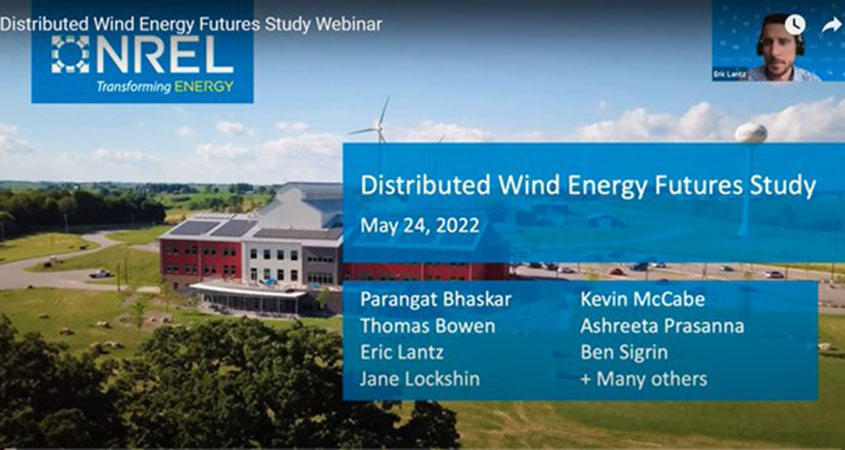
Catch up on the recording of the Distributed Wind Energy Futures Study webinar on NREL’s video playlist. Screenshot by NREL
Missed past events?
Catch up on the recording of the Eagle Behavior and Risk Modeling for Wind Energy webinar that took place in March to discuss mitigation efforts for eagles around wind turbines.
Or watch the Distributed Wind Energy Futures Study webinar from May to learn more about the terawatt-level potential for distributed wind energy in the United States.
Downwind: In Case You Missed It
NREL Researchers Appointed Editors of Wind Energy Journals
NREL wind energy researchers Paul Veers, Paul Fleming, and Amy Robertson have been named chief and associate editors of Wind Energy Science, an international scientific journal focusing on studies that provide an interdisciplinary perspective on fundamental or pioneering research in wind energy. Veers previously served for 12 years as chief editor of Wind Energy, and Fleming has authored or co-authored 20 papers for the journal. Their appointments began this month. Robertson has been renewed for another term as associate editor for the Journal of Offshore Mechanics and Arctic Engineering, a position she’s held for 4 years.
NREL Offshore Wind Energy Research Supporting New Federal-State Partnership
DOE recently announced that it is joining a new White House-led Federal-State Offshore Wind Implementation Partnership to advance the deployment of offshore wind energy in hopes of hitting the Biden administration’s goal of 30 gigawatts of capacity by 2030. DOE will lead in the formation of an offshore wind supply chain road map. Already, NREL has developed top-level needs and will release the second part of the road map by the end of 2022, which will evaluate future manufacturing scenarios, potential benefits, and industry readiness to support the supply chain growth. This NREL-led road mapping project is supported by the National Offshore Wind R&D Consortium with funding from the Wind Energy Technologies Office, New York, and Maryland.
NREL Helps Develop Colombia’s Next Generation of Renewable Energy Leaders
Early-career energy sector leaders from Colombia recently toured NREL’s Flatirons Campus, where they met Daniel Laird, center director for the National Wind Technology Center. The group comprised the 10 top-scoring and most engaged participants from the Young Leaders Variable Renewable Energy Capacity Building program as well as key project implementing partners.
NREL has been working with the Colombia government since 2017 by helping with the design, preparation, and implementation of international renewable energy auction mechanisms for large-scale solar and wind energy resources and supporting regulatory changes regarding offshore wind energy among other renewable energies and training materials.
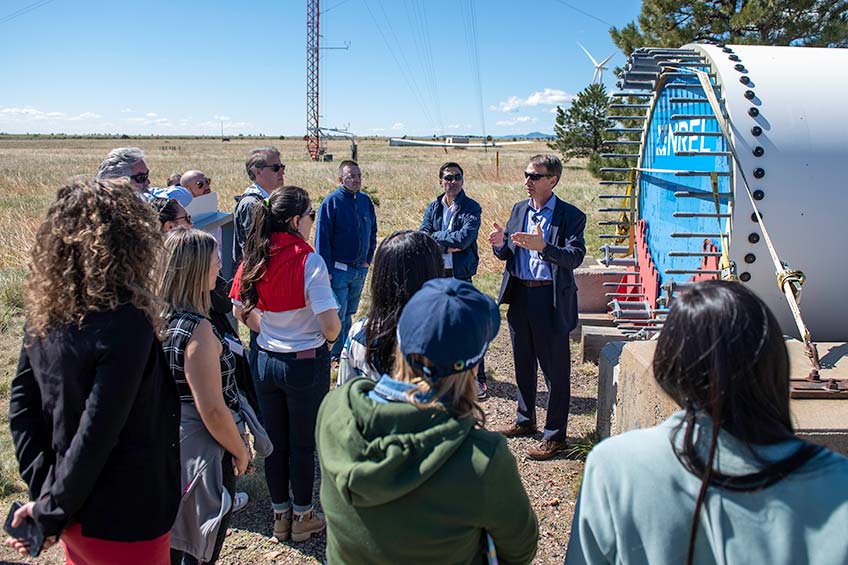
NREL Wind Energy in the News
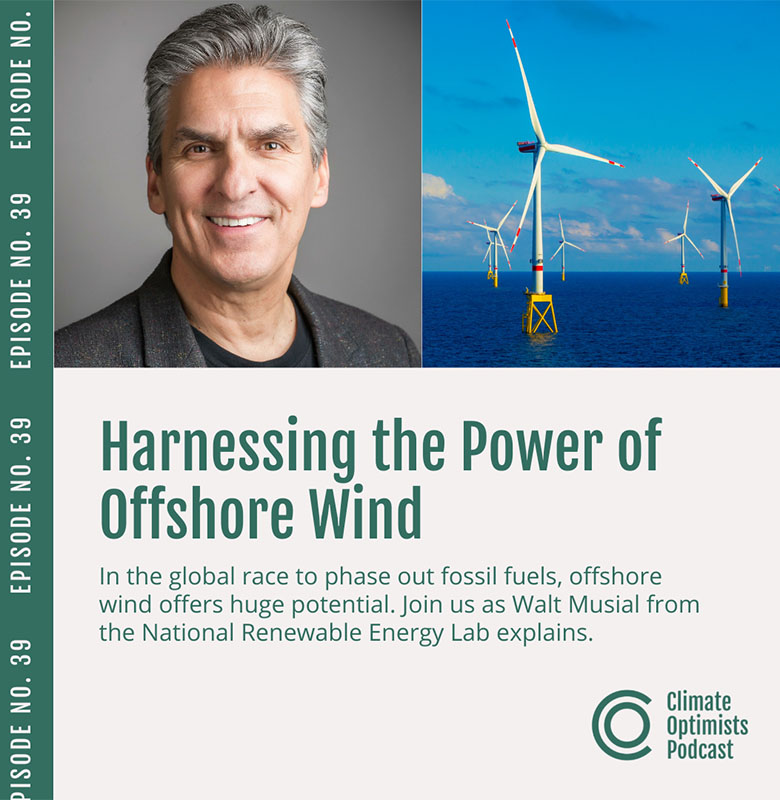
NREL offshore wind energy expert Walt Musial spoke on the Climate Optimists podcast about his journey and U.S. offshore wind energy benefits, challenges, costs, and ways it addresses climate change.
Read other mentions of NREL wind energy research in the news:
California Pulls Key Floating Wind Action Plan at Last Minute To Weigh Up “50GW By 2045,” Recharge News (2022).
ENGIE, Google Cloud Collaborate on AI and Data Management for Wind Energy, North American Windpower (2022)
Inspired by Palm Trees, Scientists Develop Hurricane-Resilient Wind Turbines, CU Boulder Today (2022)
Inspired by Palm Trees, Scientists Develop Hurricane-Resilient Wind Turbines, EurekAlert! (2022)
Inspired by Palm Trees, Scientists Develop Hurricane-Resilient Wind Turbines, Science Daily (2022)
These Bendy Wind Turbines Won’t Crack in Hurricanes, Freethink* (2022)
The US Has Had Slow Progress With Offshore Wind. This Could Be Changing, Indo & New York (2022)
NREL Electricity Technology Report Offers Distributed Wind Data for First Time, North American Windpower (2022)
NREL Predicts Wind Turbines Will Reach 130 Meters by 2035, North American Windpower (2022)
Publications
Equitable Demonstration and Deployment Roundtable Report, NREL Technical Report (2022)
Hybrid Distributed Wind and Batter Energy Storage Systems, NREL Technical Report (2022)
Understanding Power Systems Protection in the Clean Energy Future, NREL Technical Report (2022)
TORQUE Conference Papers
Floating Wind Turbine Control Optimization, Journal of Physics: Conference Series (2022)
Do Ambient Shear and Thermal Stratification Impact Wind Turbine Tip-Vortex Breakdown?, Journal of Physics: Conference Series (2022)
Design Guidelines for Deployable Wind Turbines for Defense and Disaster Response Missions, Journal of Physics: Conference Series (2022)
Serial-Refine Method for Fast Wake-Steering Yaw Optimization, Journal of Physics: Conference Series (2022)
An Open-Source Frequency-Domain Model for Floating Wind Turbine Design Optimization, Journal of Physics: Conference Series (2022)
Leading Edge Microspoilers for Load Dumping in Wind Turbine Rotors, Journal of Physics: Conference Series (2022)
Wind Turbine Gearbox Fault Prognosis Using High-Frequency SCADA Data, Journal of Physics: Conference Series (2002)
Field Tests of a Highly Flexible Downwind Ultralight Rotor To Mimic a 13-MW Turbine Rotor, Journal of Physics: Conference Series (2002)
Active Rotor Coning for a 25 MW Downwind Offshore Wind Turbine, Journal of Physics: Conference Series (2002)
Development of an Open-Source Segmented Blade Design Tool, Journal of Physics: Conference Series (2022)
Investigating the Impact of Atmospheric Conditions on Wake-Steering Performance at a Commercial Wind Plant, Journal of Physics: Conference Series (2022)
Results From the FOCAL Experiment Campaign 1: Turbine Control Co-Design, Journal of Physics: Conference Series (2022)
Aeroservoelastic Stability of a Floating Wind Turbine, Journal of Physics: Conference Series (2022)
Dynamic Inflow and Unsteady Aerodynamics Models for Modal and Stability Analyses in OpenFAST, Journal of Physics: Conference Series (2022)
Wind Turbine Blade Design With Airfoil Shape Control Using Invertible Neural Networks, Journal of Physics: Conference Series (2022)
Comparing Wind Turbine Aeroelastic Response Predictions for Turbines With increasingly Flexible Blades, Journal of Physics: Conference Series (2022)
How Generalizable Is a Machine-Learning Approach for Modeling Hub-Height Turbulence Intensity?, Journal of Physics: Conference Series (2022)
Wind Farm Response to Mesoscale-Driven Coastal Low Level Jets: A Multiscale Large Eddy Simulation Study, Journal of Physics: Conference Series (2022)
Want More?
Subscribe to The Leading Edge newsletter, and explore the latest news and accomplishments in wind energy at NREL.
Share

